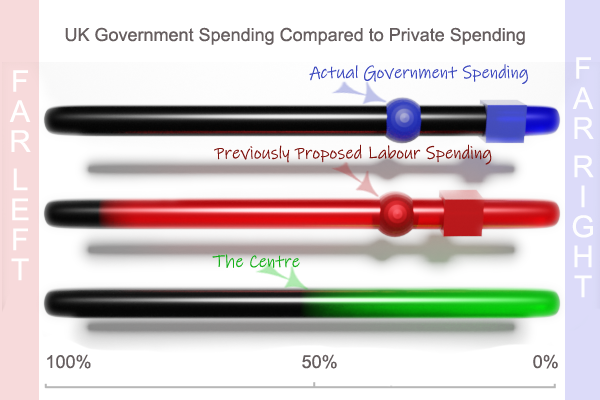

Where is the Political Centre Ground?
"Far left", "centrist" and "right wing" carry a lot of emotional baggage, but what do they actually mean? They've come to be more terms of abuse, than actual meaningful terminology, so perhaps it could be constructive to put some objective meaningful definitions to these terms.
For the record, in this discussion I'm talking about economic left and right, and not social.
What does it mean to be "Far Left" or "Central" or "Right Wing".
Context is everything. If we say a person is right wing, we might mean they're right wing compared to us, or to specific country, but the right wing in Cuba might be considered very left wing in the United States. What does the term actually mean?
We can provide an objectve framework to work within.
The Extreme Left, would be where the "workers" (state) own EVERYTHING. You can't go any further left than that.
The Extreme Right is where private enterprise (capitlists) control the entirety of the economy. There would be no government at all. No democracy. What happens is dependent on who has the money to make it happen.
Far Left is when the population, or the state as "representatives of the population", control the vast majority of the economy.
Far Right is when individuals, usually in the form of corporations, control the vast majority of the economy.
Central in that case, would be when we have a perfect balance of the above two, such that the state (on behalf of the people) is controlling half of the economy, and private individuals and corporations are controlling the other half.
These definitions are based on objective measures. They're not dependent on how right or left wing you are to me, but how right or left wing you are compared to the entire economy.
In Case thats not Clear;
A Picture Paints a Thousands Words :
In the pictures below, each bar represents the entirety of a nations GDP, that is, how much money changes hands in a year in that country.
- The top bar shows what we'd expect of a far right government. It shows very little government spending (the blue tip of the bar) because everything is under private control. Correspondingly, we have a lot of private spending (in black). The lower government spending, the blue portion shrinks "to the right."
- The second bar shows what we'd expect of a far left government., the black part shows a small amount of private spending, compared to a very large red part showing huge government spending. The higher the governmnet spending, the more that red portion expands "to the left".
- The lower bar shows what we'd expect from a genuinely central government, with an even balance between public and private spending.

Putting it into the Perspective of the UK
The blue ring on the top bar, shows current government spending. At around £800 billion it's about a third of the entire £2.5 Trillion GDP. As we'd expect from a Conservative government, it's well out to the right. That's probably a lot more than those to the right of the Tory Party would like, but given it includes all our spending on the police, fire service, army, courts, health service, councils, schools, roads, pensions, etc etc etc it's not surprising it's a significant chunk of money.
The red ring on the middle bar show Labour's proposed spending plans from 2017/19 when they were supposedly run by a "far left" leadership. So you might be a little surprised, given all you've heard about the "far left" leadership that it's also well out to the right of centre.
Government spending is around £800 Billion. With GDP at £2.5 Billion, as a nation we'd have to increase government spending by £450 Billion, just to become central, never mind left wing, never mind "far left".
An Alternative Measure - How Much Infrastructure does the Government Own Compared to Private Enterprise
This part is less accurate as exact figures are hard to come by (The ONS is apparently working on it). The diagram is to give an idea, it's not entirely accurate.
In the above diagram, The cube on the top bar represent the amount of infrastructure the government owns under the right wing conservatives. It includes things like council and government offices, schools, hospitals, police stations, roads etc etc etc. While again, I'm sure that right wing conservatives would prefer it was less, it's not zero, because the government still owns a lot of stuff, but nothing compared to what private enterprise owns.
On the middle bar the cube shows how that might change under Labour if Labour were to privatise essential monopoly infrastructure such as the railways and energy producers.
To give some idea of scale, British Gas have operating costs of a around £1.7 Billion, which is a big number, but not compared to the £2.5 TRILLION of the nations entire GDP. They employ around 30,000 people, which again, is a big number, but nothing compared to the 45 million adults in the UK. If the nationalisation plans of the previous Labour leadership were carried out, it would only increase the amount of infrastructure owned by the government by a few percent. This diagram is probably drastically over estimating the change. The point is to show just how right wing it would still be, with private corporations, and exceptionally wealthy individuals still owning the vast amount of land and infrastructure.
In Summation
In the UK (and also the US) we don't really have a mainstream "far left". We don't even have a left wing. What we have are a group of right wing parties, some of whom are not quite as right wing as some others. In pretty much any other country in Europe, the UK Labour Party would be considered right wing. The previous Labour leadership under Corbyn might have been considered central.
What we have in the UK is an extreme right wing media, owned by billionaires, who want everything to be privatised, so they can own and profit from it, who like to paint anyone who's to the left of them, as being left wing extremists.
When you look at the objective numbers, it's very clear the picture the right wing media are painting simply isn't true. All the political parties in the UK actually cover a very small amount of the economic spectrum, and they are all in the right half of the spectrum, generally crowded around the centre right where the media proscribe what is "acceptable thinking". You've actually got to go to the left, of the "far left" of the Labour Party, if you want to be objectively central.
Hopefully, that provides a little bit of perspective.